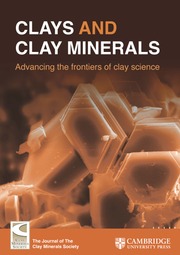Article contents
Classification of Kaolins Exemplified by Their Textures in Scan Electron Micrographs
Published online by Cambridge University Press: 01 July 2024
Abstract
Varieties of kaolin, a rock, may be classified geologically, mineralogically, crystallographically, genetically, texturally, morphologically, by industrial use, and in other ways which are desired. In this paper, the first-order of classification used is geological, i.e., transported and residual, after which other categories are used as subdivisions.
Scan electron micrographs, SEM, of the textures of kaolin show that distinctive textures characterize the several categories of classification. Varieties in texture of kaolin include similarities to those typical of sedimentary, igneous and metamorphic rocks. Because word descriptions of the textures are inadequate in comparison to pictures of them, the reader is referred to the micrographs.
SEM's illustrate differences between kaolins which were transported, formed, or deposited from solution, a colloidal phase, or as orthodox clastic particles. The parent source of kaolin deposited, or “grown,” from solution may be difficult to ascertain. It is suggested that the total role of solution work in kaolin petrology can be more important than has ordinarily been credited.
Резюме
Разновидности каолина,горной породы,могут быть классифицированы по геологическим,минералогическим,кристаллографическим,генетическим,структурным и морфологическим признакам,по промышленному использованию и другим показателям. В этой статье геологическая классификация используется в качестве основной,т.е.разновидности каолина подразделяются на привнесенные и остаточные, в то время как другие категории используются в качестве более мелких подразделений.
Микроснимки структур каолина,сделанные с помощью развертывающего электронного микроскопа,показывают,что четкие структуры определяют несколько классификационных категорий.Разновидности структур каолина подобны типичным структурам осадочных,изверженных и метаморфических пород.Поскольку словесные описания стрктур не адекватны визуальным наблюдениям,в статье приводятся микроснимки.
Микроснимки иллюстрируют различия между каолинами,которые были привнесены, сформированы или отложились из коллоидальной фазы раствора или в виде обычных обломочных частиц.Первоисточник каолина,отложенного,или "рожденного" раствором,вероятно,установить трудно.Предполагается,что в целом роль деятельности раствора в петрологии каолина более важна,чем обычно принято думать.
Information
- Type
- Research Article
- Information
- Copyright
- Copyright © 1978, The Clay Minerals Society
References
- 81
- Cited by

